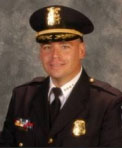Dave Briggs made that quip at the Policing 2.0: The Citizen and Social Media conference in England on October 22nd. #polcasm is the Twitter hashtag for the event, which was sponsored by the National Policing Improvement Agency (NPIA).
 There was indeed much to get excited about at #polcasm. Three things stick out in my mind as highlightes: 1) The “Balance Your Bobby” project in North Wales and well as the agency’s approach to neighborhood policing and its incorporation of Facebook, 2) William Perrin’s “Talk About Local” project and 3) the presentation by Lauren Currie and Sarah Drummond about mypolice.org.
There was indeed much to get excited about at #polcasm. Three things stick out in my mind as highlightes: 1) The “Balance Your Bobby” project in North Wales and well as the agency’s approach to neighborhood policing and its incorporation of Facebook, 2) William Perrin’s “Talk About Local” project and 3) the presentation by Lauren Currie and Sarah Drummond about mypolice.org.
Inspector Ian Davies of North Wales Police presented the “Balance Your Bobby” project. It’s an online system for citizens to influence where the officers should focus attention within the police jurisdiction. What I learned from Ian the night before at dinner was even more interesting to me and was one of the only real uses of social media tools, as opposed to innovative new website-creation tools, that I learned about at the conference.
Upon landing at the North Wales Police website, you’re presented with the option to choose your neighborhood.
 Once you select it, the next page offers a Facebook site for each and every neighbourhood. On the Facebook page, the officers assigned to that neighborhood offer information and every single one of them is listed, complete with how to contact them. It seems like a simple idea, but many police departments covet their officer phone numbers and email addresses as top-secret info. What the heck for? Even more interesting, Ian said each officer is not allowed to interact on the sites with their personal accounts, only with their official department profiles which were set up and managed by the police department.
Once you select it, the next page offers a Facebook site for each and every neighbourhood. On the Facebook page, the officers assigned to that neighborhood offer information and every single one of them is listed, complete with how to contact them. It seems like a simple idea, but many police departments covet their officer phone numbers and email addresses as top-secret info. What the heck for? Even more interesting, Ian said each officer is not allowed to interact on the sites with their personal accounts, only with their official department profiles which were set up and managed by the police department.
Talk about Local is awesome. It enables communities to create their own local sites in their neighborhoods to facilitate communication about safety issues and to become more involved with improving their own areas. talkaboutlocal.org was created by William Perrin, a former civil servant and private secretary to Tony Blair.
Unfortunately the mypolice.org service has yet to be launched. It reminds me of ratemycop.com, which isn’t necessarily a good thing. But what’s different about mypolice is that the conversation can go both ways between citizens and police. When it’s up and running it promises to be a tool, for all of the UK, for people to post comments or to provide suggestion for improvements and invaluable insight. They hope to reach groups that are often not heard from and provide a way for the law enforcement agencies to interactive with all citizens. I’ll try to keep an eye on the service and report back.
I was asked several times while at the conference and since returning home how what’s going on in the UK compares to what police departments in North America are doing in the social media world. According to Mike Alderson, (@openeyecomms) 15 of the 44 police services in England and Wales are on Twitter. But from my own observation they make the same mistakes with Twitter as police agencies everywhere: they don’t engage, they follow few, and they don’t tweet with an identity other than the PD.
But the fact remains that more and more law enforcement agencies everywhere are using social media and many are doing it very well. If each agency could learn from the best practices of others, we’d achieve greatness in real time. Suffice it to say “real time” is not happening, but the ball is picking up speed.
A huge thank-you to Nick Keane of the NPIA for including me in an outstanding day.








